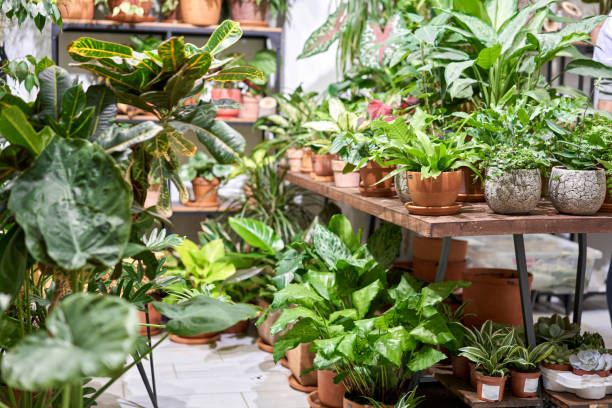Indoor plants improve your living environment, filter the air, and bring a little bit of nature inside. However, not everyone has the time or energy to maintain high-maintenance plants that need constant care. Fortunately, many low-maintenance indoor plants are easy to care for and perfect for both beginner and busy plant owners. In this article, we will explore some of the best low-maintenance indoor plants and provide tips on how to care for them.
1. Snake Plant (Sansevieria)

Mother-in-law’s tongue, or snake plants, are among the most well-liked low-maintenance houseplants. It is known for its stiff, upright leaves that can grow to be several feet tall. The plant is extremely hardy and can tolerate a variety of lighting conditions, including low light, making it an ideal choice for apartments and offices.
Care Tips:
Light: Snake plants thrive in indirect light but can also survive in low-light conditions.
Watering: In between waterings, let the soil totally dry out. It’s advisable to water it lightly because overwatering can cause root rot.
Humidity: Snake plants are drought-tolerant and don’t need high humidity.
2. ZZ Plant (Zamioculcas zamiifolia)
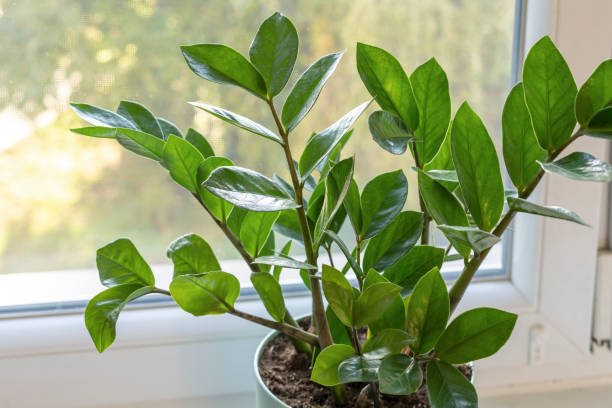
The ZZ plant is another excellent choice for anyone looking for a plant that requires minimal attention. It features thick, glossy leaves that are drought-resistant, making it perfect for those who may forget to water their plants occasionally.
Care Tips:
Light: ZZ plants prefer bright, indirect light but can also tolerate low-light conditions.
Watering: Water the plant every 2-3 weeks, allowing the soil to dry between waterings.
Humidity: It adapts well to a wide range of humidity levels, making it perfect for any indoor environment.
3. Pothos (Epipremnum aureum)
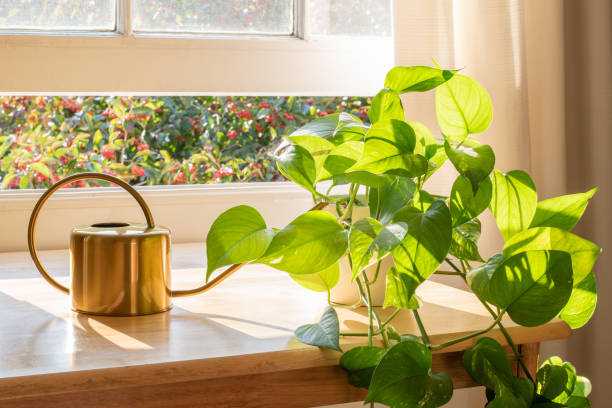
Pothos, also known as devil’s ivy, is a vining plant with heart-shaped leaves that can thrive in low-light conditions. This plant is popular for its ability to grow long, trailing vines, making it an ideal plant for hanging baskets or shelves.
Care Tips:
Light: Pothos grows well in low to medium light but can also tolerate bright, indirect light.
Watering: When the top inch of soil seems dry, water it. Pothos can handle occasional dry spells, making it very forgiving.
Humidity: It does well in standard indoor humidity but can benefit from occasional misting.
4. Spider Plant (Chlorophytum comosum)

The spider plant is known for its long, arching leaves with green and white stripes. It produces “spiderettes,” or small offshoots, that can be propagated easily. Spider plants are easy to grow and adapt well to various environments.
Care Tips:
Light: Though it can endure low light, it prefers bright, indirect light.
Watering: Water the plant when the top layer of soil is dry, and avoid overwatering.
Humidity: Spider plants thrive in moderate humidity but can tolerate dry air.
5. Aloe Vera

Aloe vera is a succulent plant that is not only easy to care for but also useful. The gel inside the leaves has soothing properties that can be applied to minor cuts and burns. This hardy plant is perfect for those who prefer a plant with multiple benefits.
Care Tips:
Light: Aloe vera thrives in bright, indirect sunlight but can handle some direct sun as well.
Watering: Water every 2-3 weeks, allowing the soil to dry out between waterings.
Humidity: Aloe vera is drought-tolerant and prefers a dry environment.
6. Peace Lily (Spathiphyllum)

The peace lily is a beautiful indoor plant with dark green leaves and stunning white flowers. Not only is it easy to care for, but it also helps purify the air by removing toxins.
Care Tips:
Light: Peace lilies prefer medium to low light and can even thrive in shaded areas.
Watering: Keep the soil slightly moist, but don’t overwater. When the leaves begin to droop a little, water them.
Humidity: It thrives in higher humidity, so misting the plant occasionally will help.
7. Philodendron
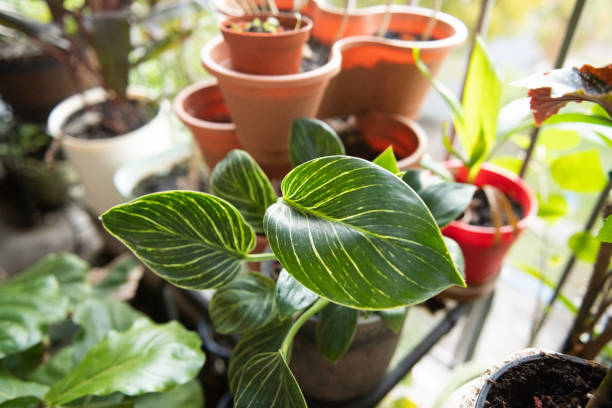
Philodendrons are versatile, low-maintenance plants with large, heart-shaped leaves. They are perfect for those who want a plant that can grow in different light conditions and require little care.
Care Tips:
Light: Although they may tolerate reduced light levels, philodendrons prefer bright, indirect light.
Watering: When the top inch of soil seems dry, water it. Root rot can result from leaving the plant submerged in water.
Humidity: It does well in average indoor humidity, but it can thrive with occasional misting.
8. Cast Iron Plant (Aspidistra elatior)
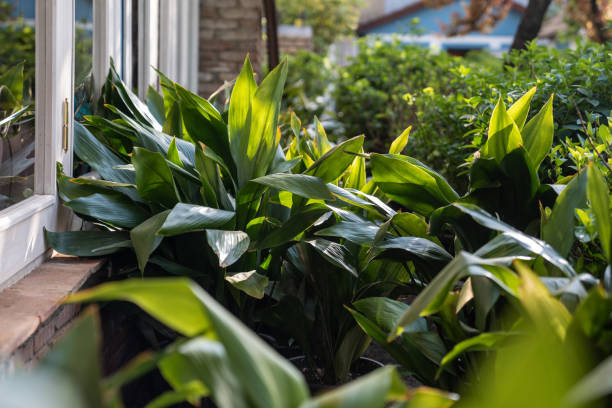
The cast iron plant lives up to its name—it is incredibly durable and nearly indestructible. With dark green, glossy leaves, this plant is perfect for low-light rooms or spaces where other plants may struggle.
Care Tips:
Light: Can tolerate low to medium light but does best in indirect light.
Watering: When the soil’s top inch becomes dry, water it. It is very drought-tolerant and can go weeks without water.
Humidity: The cast iron plant is not picky about humidity levels, making it ideal for any indoor setting.
Benefits of Low Maintenance Indoor Plants
Low-maintenance indoor plants offer several advantages beyond their aesthetic appeal. These plants can improve air quality by removing pollutants like formaldehyde, benzene, and carbon monoxide. Additionally, they help reduce stress, enhance productivity, and create a calming atmosphere in your home or office.
General Care Tips for Low Maintenance Indoor Plants
Even though these plants are low-maintenance, they still require some basic care to thrive:
Lighting: Most low-maintenance plants prefer indirect or low light. Avoid placing them in direct sunlight unless specified.
Watering: Overwatering is a common mistake. Always allow the soil to dry out between waterings and make sure your pots have proper drainage.
Soil: To avoid root rot, use soil that drains properly.
Humidity: While most low-maintenance plants adapt well to indoor humidity, occasional misting can help, especially during dry seasons.
Pest Control: Keep an eye out for pests like spider mites and aphids, and treat them promptly with natural solutions or insecticidal soap.
Conclusion
Low-maintenance indoor plants are perfect for busy individuals or beginner plant parents who want to enjoy the benefits of greenery without the hassle. With minimal effort, these plants can thrive in various lighting conditions and environments, making them ideal companions for any space. Whether you choose a snake plant, a ZZ plant, or a peace lily, these resilient plants will reward you with beauty, clean air, and a touch of nature inside your home.
Read More: The Top 10 Houseplants for Your Kitchen
FAQs About Low Maintenance Indoor Plants
1. What makes a plant low-maintenance?
Low-maintenance plants are those that require minimal care, such as less frequent watering, lower light requirements, and the ability to thrive in a variety of conditions. They are typically more resistant to pests and disease, making them ideal for busy or inexperienced plant owners.
2. How often should I water low-maintenance indoor plants?
The watering frequency depends on the plant type, but most low-maintenance plants should only be watered when the top inch or two of soil is dry. Overwatering is a common mistake, so it’s important to allow the soil to dry out between waterings.
3. Can low-maintenance plants survive in low light?
Yes, many low-maintenance plants, such as snake plants, ZZ plants, and pothos, can thrive in low-light environments. While they may grow more slowly, they are still able to survive and maintain their health in less-than-ideal lighting conditions.
4. Do low-maintenance plants help purify the air?
Yes, several low-maintenance plants, such as the peace lily, snake plant, and spider plant, are known for their air-purifying qualities. They can remove toxins like formaldehyde, benzene, and carbon monoxide, improving indoor air quality.
5. Do low-maintenance plants need fertilizer?
While low-maintenance plants don’t require frequent fertilization, feeding them once or twice a year during the growing season (spring and summer) with a balanced houseplant fertilizer can encourage healthy growth.

